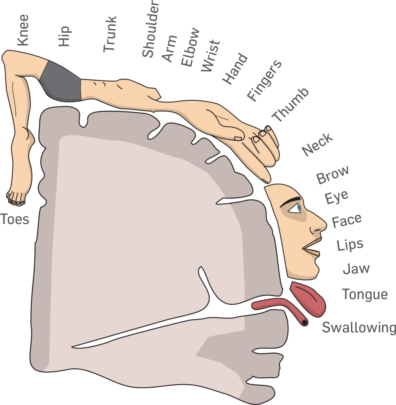Dear Yulissa,
Your brain weighs less than 3 pounds but has the power to move your whole body. That’s because it’s part of your nervous system.
Your brain and the spinal cord that runs down your back make up your central nervous system. You also have a peripheral nervous system made up of nerve cells. These connect your brain and spinal cord to all the other parts of your body.

I talked about how your brain signals your body to move with my friend Samantha Gizerian, professor of Integrative Physiology and Neuroscience at Washington State University.
She told me that the brain processes movement in three steps.
First, your senses tell your brain what’s going on around you and what position your body is in. Next, your brain uses that sensory input to plan how to move. Then, your brain sends signals that tell your muscles to contract.
One part of the brain that’s involved in movement is the motor cortex.
“It sits right before your ears but up at the top,” Gizerian said. “It’s the part that sends the signals down to your muscles to tell them to move. But it also has a map. So, there’s a particular part of motor cortex that moves your head. There’s another part that moves your hands and your fingers. There’s another part that moves your arms, your legs, your feet.”
The map is called your homunculus. That means “little man” because the map can be drawn to look like a person with huge hands. The size of the body part in the drawing shows how much of your motor cortex is dedicated to moving that part of your body.


So, let’s say you want to write. How does the motor cortex tell your hand to move?
“The part of the motor cortex that’s responsible for the parts of the hand that will be moving fires a signal,” Gizerian said. “Those signals travel down through the brain stem and spinal cord and pass that signal on to a neuron that goes out to the muscles. Then the muscles contract.”
Neurons are nerves cells. The ones that come from your brain and spinal cord out to your muscles are called motor neurons—because they motor you around. You have about 500,000 motor neurons in your body!
Neurons use electrical and chemical signals to tell your muscles to contract or relax. That makes your muscles pull on your bones, which is how your body moves.
To make sure your movements are smooth, another part of your brain steps in. The cerebellum is the bump at the back of your brain. The signals your motor cortex sends to your muscles are copied there. It helps correct your motion and provides muscle memory.
An activity like writing is what neuroscientists call a motor program. When you run a motor program over and over, your brain gets lots of feedback from your joints, skin and muscles. It uses that feedback to make tiny corrections in your motor program. Eventually, writing is easy and beautiful.
It’s all thanks to your brain.
Sincerely,
Dr. Universe